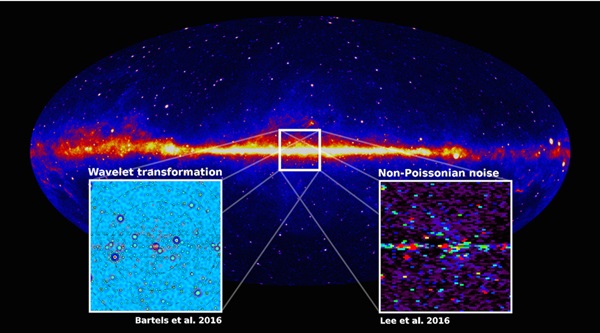Key Takeaways:
In 2009, observations with the Fermi Large Area Telescope revealed an excess of high-energy photons, or gamma rays, at the center of our galaxy. It was long speculated that this gamma ray excess could be a signal of dark matter annihilation. If true, it would constitute a breakthrough in fundamental physics and a major step forward in our understanding of the matter constituents of the universe.
However, many other hypotheses have emerged in recent years, suggesting the gamma ray excess in the center of our galaxy might have a more ordinary astrophysical cause. Possible origins for the observed gamma ray excess range from the activity of the supermassive black hole in the center of our Milky Way and star formation in the central molecular zone to the combined emission of a new dim source population in the galactic bulge.
Millisecond pulsars
New statistical analyses of the Fermi data by Christoph Weniger from UvA and a research group from Princeton/MIT now strongly suggest that the excess emission does indeed originate from unresolved point sources. The best candidates are millisecond pulsars, the researchers conclude.
Millisecond pulsars, or rapidly rotating neutron stars, were often formed billions of years ago. They are among the most extreme objects in the galaxy. A population of hundreds or thousands of these millisecond pulsars must be lurking in the galactic center, hidden from detection due to present day instrument sensitivity. Future radio surveys with existing and upcoming telescopes — e.g., Green Bank Telescope, Square Kilometre Array — will be able to further test this hypothesis in the coming years.
Win-win situation
In their analyses, the UvA and Princeton/MIT researchers each used a different statistical technique, “non-Poissonian noise” and “wavelet transformation,” to analyze the Fermi data. What they found was that the distribution of photons was clumpy rather than smooth, indicating that the gamma rays were unlikely to be caused by dark matter particle collisions.
According to Weniger, this is a win-win situation: “Either we find hundreds or thousands of millisecond pulsars in the upcoming decade, shedding light on the history of the Milky Way, or we find nothing. In the latter case, a dark matter explanation for the gamma ray excess will become much more obvious.”
Mariangela Lisanti from Princeton University said: “The results of our analysis probably mean that what we are seeing is evidence for a new population of astrophysical sources in the center of the galaxy. That in itself is something new and surprising.”










